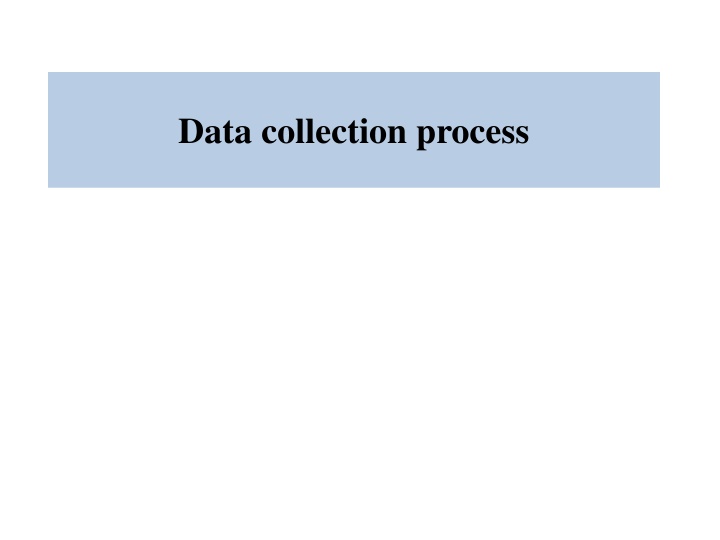
Data Collection Process and Methods for Research Studies
Explore the data collection process, sources, methods like interviews and questionnaires, along with their benefits and processes. Understand how to select the right methods based on study requirements and population characteristics for effective research.
Uploaded on | 0 Views
Download Presentation

Please find below an Image/Link to download the presentation.
The content on the website is provided AS IS for your information and personal use only. It may not be sold, licensed, or shared on other websites without obtaining consent from the author. If you encounter any issues during the download, it is possible that the publisher has removed the file from their server.
You are allowed to download the files provided on this website for personal or commercial use, subject to the condition that they are used lawfully. All files are the property of their respective owners.
The content on the website is provided AS IS for your information and personal use only. It may not be sold, licensed, or shared on other websites without obtaining consent from the author.
E N D
Presentation Transcript
Data Collection Data are the observable and measurable facts that provide information about phenomenon under study.
Data Sources Primary sources- Primary data are directly collected from the research units, which may be individuals, objects, programmes, or institutions. Secondary sources- Secondary data are collected from either internal or external secondary sources.
Selection of methods of data collection The nature of phenomenon under study Type of research subjects Type of research study The purpose of research study Size of study sample Distribution of target population Time frame Literacy level of subjects Availability of resources and manpower Researcher s knowledge level and manpower
Methods of data collection Interview Questioning Observation Biophysiological methods Other methods
Interview A method of data collection in which one person (interviewer) asks the questions from another person (respondent), which is conducted either face to face or telephonically.
Benefits Provide in-depth and detailed information Permits greater depth of response Data from illiterate subjects Higher response Clarify misunderstandings Ask questions at several levels Use of special devices Accuracy can be checked Flexible and adaptable
Interviewing Process Preparation for interview Pre-interview introduction Developing rapport Carrying the interview forward Recording the interview Closing the interview
Questionnaire A questionnaire is a planned self-reported form designed to elicit information though written or verbal responses of the subjects.
Types of questions Open-format questions- These are those questions which provide opportunity to the respondents to express their opinions and answers in their own way. Closed format questions- These questions offer respondents a number of alternative replies, from which the subjects must choose the one that most likely matches the appropriate answer.
Closed format questions Dichotomus questions Multiple choice questions Cafeteria questions Rank order questions Contingency questions Rating questions Importance questions Likert questions Bipolar questions Matrix questions
Likert Scale It is a composite measure of attitudes that involve summation of scores on set of items(statements) to which respondents are asked to indicate their degree of agreement or disagreement.
Example Statement Strongly agree Agree Uncertain Disagree Strongly disagree You can get AIDS by sharing utensils (negative Statement) Person with multiple sex partners are at high risk of AIDS (Positive statement) 1 2 3 4 5 5 4 3 2 1
Characteristics Psychological measurement scale Illustrative in nature Neutral Statements Bipolar scaling method Measurement of the specific number of scaling categories
Observation It is a part process to collect data for study that includes an observer ( someone who is observing) and the observed ( there is something to observe).
Types Structured observation Unstructured observation Participant observation Nonparticipant observation
Planning for observation Determine the focus Design a system for data collection Select the sites Select the observer Train the observers Time your observations appropriately
Rating Scale Rating scale refers to a scale with set of opinion, which describes varying degree of the dimensions of an attitude being observed.
3 point scale Always Sometimes Never 5 point scale- No pain 1 2 3 4 Worst pain
Types of Rating scales Graphic rating scale Descriptive rating scale Numerical rating scale Comparative rating scale
Checklist A checklist is a simple instrument consisting prepared list of expected items of performance or attributes, which are checked by a researcher for their presence or absence.
S.No. Behaviours Remarks Place for ( ) tick mark Yes No 1. Do Handwashing 2. Wear Gloves 3. Maintains aseptic technique
Biophysiological Methods It involves the collection of biophysiological data from subjects by using the specialized equipments to determine physical and biological status of subjects.
Types of Biophysiological Methods In vivo biophysiological methods In vitro biophysiological methods
Projective Techniques These attritbutes(value, respondents with unstructured stimuli to which they respond. are methods attitudes, for measuring and personality psychological providing
Validity Validity refers to an instrument or test actually testing what to be testing. - Treece and Treece Validity refers to the degree to which an instrument measures what it suppose to measuring. - Polit and Hungler
Types Face validity- It involves an overall look of an instrument regarding its appropriateness to measure a particular attribute or phenomenon. Content validity- It is concerned with scope of coverage of the content area to be measured. Criterion validity- This type of validity is a relationship between measurements of the instrument with some other external criteria. Construct validity- It is a key criterion for assessing the quality of a study, and construct validity has most often been addressed in terms of measurement issues.
Reliability Reliability is the degree of consistency and accuracy with which an instrument measures the attribute for which it is designed to measure.
Measuring of Reliability Stability- The stability aspect of reliability means research instrument provides same results when it is used consecutively for two or more times. Internal consistency- It is also called homogenity. Internal consistency ensures that all the subparts of a research instrument measure the same characteristics. Equivalence- In this a researcher is testing the reliability of a tool, which is used by two different observers to observe a single phenomenon
Pilot study It is referred to a small-scale preliminary tryout of the method to be used in an actually large study.

